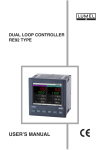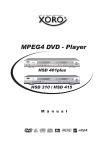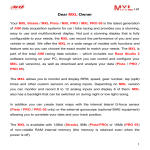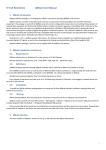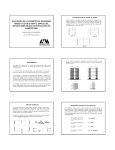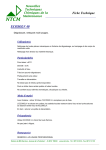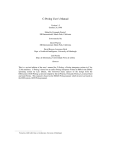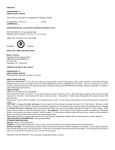Download PowerWatcher user manual
Transcript
PowerWatcher user manual PowerWatcher device is intended for data measurement, indication and storage of the major operational parameters of an electric vehicle, electric scooter or other electric transportation means. The device is capable of measuring a current, voltage, speed, defined point temperature, and of indicating a number of parameters calculated as functions thereof, e.g. a power, energy consumption rate, number of charge/discharge cycles, mileage, etc. Data is indicated via an external device which can be an Android (v3.0 or newer) based smartphone or a tablet capable of supporting the OTG function. Power supply range of the PowerWatcher is 50…250V DC (practically down to 30V DC in the most cases). Measured current range depends on the shunt resistance. Full scale range (for ADC purpose) of the shunt voltage is from -120mV to +120mV. Connecting the sensors Use any suitable shunt for the current measurement, taking into account your range of current as suggested above. Set shunt resistance in microOhms in the settings menu. Temperature measurement is calibrated for NTCM-100K thermoresistor type. Use a hercon from bike-computer or a Hall sensor with an open-collector output as a speed sensor. Connecting a smartphone PowerWatcher works as “USB Device”, hence smartphone must be able to support OTG. The simplest test to check this ability is connecting USB-flash memory stick to a smartphone and making sure that it works. Connectors pin-out VGA interface connector a.k.a. DE-15/ DSUB15 is used for sensors connection. Alternatively some or all of the connecting wires can be directly soldered into PCB to minimize errors caused by contact resistance. DSUB15 pin-out. Pin number Function 1 Shunt - 2 Shunt + 3 Common potential (minus of traction battery) 4 Common potential (for thermo sensor return) 5 Battery + 6 Thermo sensor + 7 Not used 8 +5V (sensors power supply) 9 Common potential 10 Common potential 11 RX 12 TX 13 Speed sensor 1 14 Speed sensor 2 15 Common potential Pin-out for direct wire soldering into PCB bypassing the DSUB15 connector: Pin number Function 1 Battery + 2 Not used 3 Not used 4 Common potential (minus of traction battery) 5 Common potential 6 Not used 7 Shunt + 8 Shunt - 9 Not used 10 Thermo sensor + 11 +5V (sensors power supply) 12 RX 13 TX 14 Speed sensor 1 15 Speed sensor 2 Software deployment on Android based device 1. Check USB Host function of your smartphone. Download “USB Host Diagnostics” from Play Market and run it. Run the diagnostics and agree to “fix errors” as the program propmts. 2. Download “PowerWatcher” program from Play Market. 3. After the connection of your smartphone to PowerWatcher device the software will run automatically. Warning: Device gives power supply from battery (not from USB!). So device works only then it connected to battery. Setting the software “PowerWatcher” software has 3 screens – “Display”, “All parameters” and “Settings”. Switching between the screens is by double tap. - “Main screen” or “Display” solely indicates the selected parameters. - “All parameters” screen allows selecting the parameter set to be indicated on the “Display” - screen. “Settings” screen allows changing general settings. There are several initial settings to be done prior to use: “Wheel length” for correct speed and distance calculation; “Shunt resistance” for correct current derived parameters calculation; “Battery capacity”; “Charged voltage” i.e. voltage of the traction battery when it is fully charged. To adjust current consumption indication if it differs from zero in idling condition of a vehicle, press the button “Reset current offset to zero”. Working algorithm For correct calculations of energy related data the PowerWatcher device must be connected to the traction battery at all times, i.e. while charging and discharging. The criterion of the end-of-charging during the charging process is defined as: - the battery voltage having exceeded the pre-set value of “Charged voltage”; - and 1% of “Battery capacity” extra charge added into the battery after that event. When the end-of-charging criterion is satisfied, then a number of other parameters gets reset, e.g. daily mileage, consumed energy, average and peak speed, current, etc. Battery charge level is then set at 100%. The remaining battery charge percentage is calculated based on the full battery capacity and spent charge in amp-hours.




